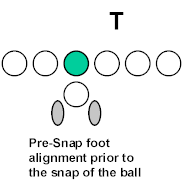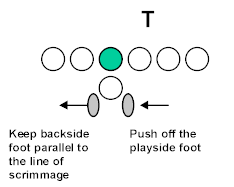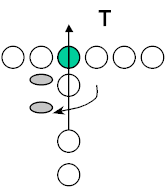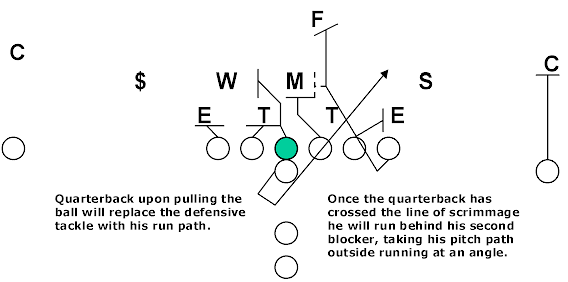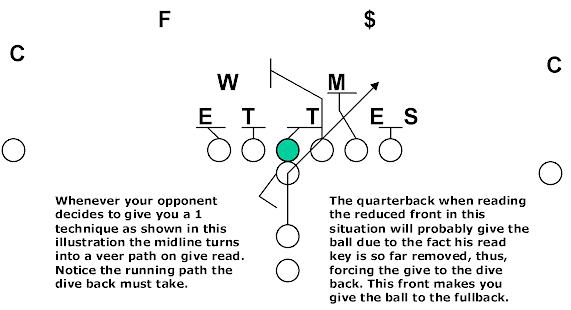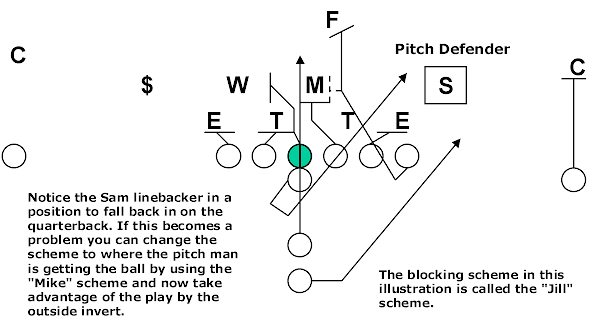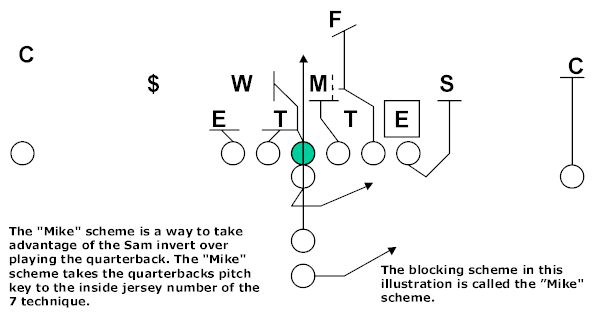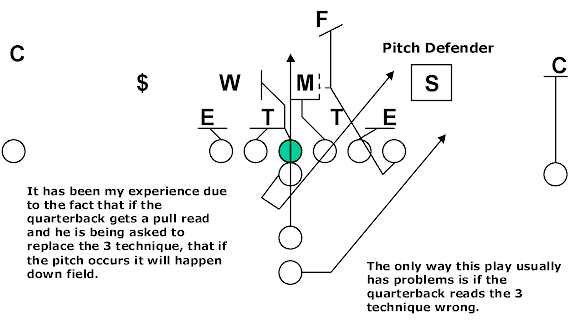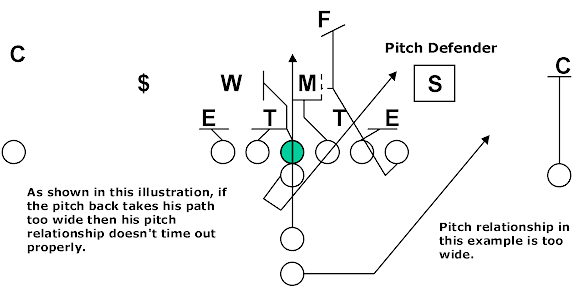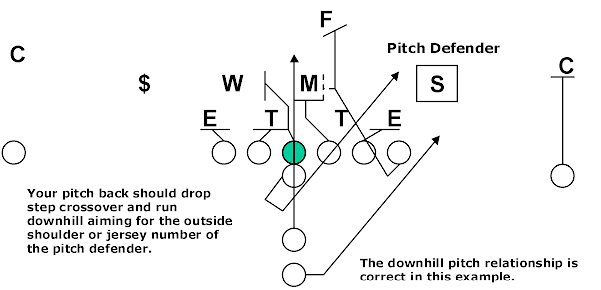|
Coaching Quarterback Mechanics and Mesh for
Football's Midline
Option The Midline Option read is considered one of the easiest options to install due to the closeness of the read. On the midline option which we will call 10 or 11, you will want to run it to a 3 or 2 technique for best results and for true midline mechanics. On Midline Option you will want to teach your quarterback to read the inside jersey number of the defensive tackle. There are several different ways to teach the quarterback his footwork, the one I like to teach is called push away step at 6:00 O'clock. What push away means is that when the quarterback receives the football, he will push off his play side foot with the backside foot stepping away and parallel to the line of scrimmage. After pushing off his playside foot he then will step at 6:00 O'clock with that foot, which gets the quarterback out of the path of the fullback who is running at the mid point of the center. The following examples illustrate the initial footwork by the quarterback:
Example number 3 shows the quarterback out of the way of the dive back. The quarterbacks heels and toes should be pointing towards the sideline. Quarterback reaches the ball back to the dive back as deep as possible with his eyes on the inside jersey number of the 3 technique. By keeping your quarterback on the line of scrimmage with his initial steps and running downhill after the ball has been pulled will help negate penetration by the defensive players.
Once again the inside jersey number of the 3 or 2 technique dictates the give or pull read. The give read happens when the quarterback sees the inside jersey number come down or he can see the white of the number. By reaching the ball back as deep as possible for a longer ride this invites the down defender to make a decision one way or the other now so he can't play soft in the hole, thus, being able to play both give and or pull. If the ride is shorten then the defender plays softer, if the ride is longer it usually brings him to the dive. A key coaching point with any dive mesh is to tell the running back to run with his eyes and head up as he goes through the hole. Whenever the back drops his eyes and head it makes him clamp harder to the ball, if he runs with his eyes and head up it makes for a softer pocket, smoother exchange and better mesh between quarterback and dive back. If the quarterback gets the give read from the down defender he should carry his option fake on out, make the defense believe that he still has the ball. Another point to remember here is if you, during a ball game, see that the 3 or 2 technique is taking the quarterback and or playing upfield then compliment the midline with the trap, this will keep the defender from playing upfield and more apt to take the dive. The pull read by the quarterback is dictated by the down defender showing his jersey number to the quarterback and or just simply coming down and attacking the dive back. As the quarterback keys the inside jersey number the pull will be dictated by the down defender taking the dive. As the quarterback reaches the ball back and rides the dive back through the hole and he pulls the ball he wants to replace the defensive tackle taking the dive. Again, replace the down defender keeping your path into the line of scrimmage because this negates the penetration by the defense. Remember, you will always track the play side linebacker and free safety with two offensive blockers: One being the playside guard and two depending upon you blocking scheme the tackle, tight end, running back, and or wing back. A problem that usually occurs when the quarterback takes it up and into the line of scrimmage is cutting up to sharply and not allowing the second blocker to clear. Your quarterback upon keeping the ball and turning up into the line of scrimmage should run behind the second blocker coming through the line of scrimmage, keeping his path running outside. The following examples will illustrate the quarterback's path when running up and into the line of scrimmage:
As I present 10 - 11 Midline Option I'm going to illustrate several different ways in which to install the midline. As you all know, and for those just starting out, your opponent has several ways in which to defense the midline and also take the midline away and dictate which person they want to carry the football.
Several other situations to consider are as follows. Most defensive coaches know that this play is usually a give or quarterback keep play, so, whenever the quarterback turns upfield running the ball the defense will have their outside invert or strong safety fall back in on the quarterback. By blocking scheme the invert is unaccounted for and you as an offense his opening the invert will cover pitch player. The pitch usually never occurs until the quarterback is downfield, thus, the invert comes off the pitch and takes the quarterback - as the following illustration will show.
As you read through this manual and follow the installation of plays for the midline you will gain a better understanding for the quarterbacks mechanics and how this play is designed. Now we will begin to discuss the key coaching points for the running backs. The first player we want to talk about is the dive back. The dive back in the midline play is the back aligned directly behind the quarterback.
On the Midline play the dive back will take his running and aiming point at the mid point of the center. It is very important that the dive back understands that while running through the mesh with the quarterback that he keeps his eyes and head up. When the dive back approaches the mesh with his head down it makes for a rough mesh. When the dive back has his head down it tends to make him squeeze or clamp down on the ball to hard, thus, making it difficult for the quarterback to pull the ball if he gets a pull read by the down defender taking the dive. The following illustration will show the path by the dive back.
Once the dive back or fullback hits the line of scrimmage you need to make sure if the quarterback pulls the ball that he continues to carry out his run fake, must make the defense think he has the ball. The fullback plays from a balanced three point stance with his weight evenly distributed across both feet. The next step to installing the Midline Option is the action of the pitch back. Many different backfield sets and formations exist and there are numerous ways in which to run the midline, but for purposes of this manual I will call the pitch back the Tailback. I will illustrate the Tailbacks position from the "I" backfield set and do understand that their are numerous ways to get him in a position to receive the pitch and one of those coming off motion. For the most part the midline is a triple option play which gets the ball into the Tailbacks hands past the line of scrimmage not behind it unless, the "Mike" scheme is installed. The following illustration will explain some key coaching points to remember when coaching the Tailback.
The Tailback plays from a two point stance with vision on the entire field. When the ball is snapped and or starting from the "I" back position the depth of the pitch back is approximately seven yards deep. The initial footwork for the Tailback is called drop-step crossover, get downhill running at the outside jersey number of the pitch defender. For the purpose of this explanation I have used the "Jill" fold scheme. A major coaching point for this type of scheme that doesn't release the E.M.L.O.S. is for the Tailback to run downhill coming off the initial drop-step. If the quarterback pulls the ball and replaces the down defender it puts him into the line of scrimmage now. Thus, if the Tailback releases flat and parallel to the line of scrimmage then it will be hard to get the Tailback into a proper pitch relationship, which then will allow the outside invert to fall back into helping make the play on the quarterback. If the Tailback attacks the outside shoulder or jersey number of the pitch defender immediately, it then draws the attention of the outside invert away from falling back inside on the quarterback. Something I tell our Pitchback or Tailback is that when he crosses the line of scrimmage start to yell ball, ball, ball this to will draw the attention of the outside invert and keep him in no mans land. By running the Tailback downhill immediately this will get him in his desired pitch relationship with the quarterback so if the quarterback does have to pitch the ball because, the invert takes quarterback the pitchman will be in his proper pitch relationship and the quarterback can kick the ball out. The following illustrations will show you what I mean by this.
Editor's Note: Comments and questions can be directed to Jerry by visiting his web site at www.jerrycampbellfootball.com
| |||||||||||||||||||||||||
